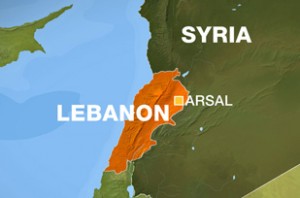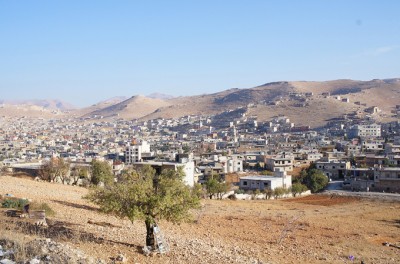
Arsal, Lebanon – For more than a week, thousands of Syrian refugees have poured into this hilltop town. They are fleeing the Syrian army takeover of Qara in the mountainous Qalamoun region along Lebanon’s eastern border, and the highway linking Damascus with the city of Homs.
Aala Hamid, a soft-spoken 20-year-old mother, has recently arrived from Qara. She cradled her son in a crowded downtown clinic as she patiently waited to hear about vaccination shots.
On November 15, Aala’s family hid in their dark basement as shells bombarded Qara and struck part of their home. During a brief ceasefire they, along with their neighbors, piled into a van and drove along worn smuggling paths through the night, and across the border to Arsal.
“There were bombs and shelling,” she said. “I know many people who were injured by shrapnel, or who lost their husbands. One woman died because her roof fell on top of her.”
Aala, her husband and two young children now sleep with 15 other refugees in one room. There are no mattresses on the floor, and she said they brought nothing with them. “We don’t have food or money, and we know the owner will ask us for rent. We’d rather go home than live in a tent.”
But for the time being, Aala, like thousands of others, will remain. “People won’t go back because it’s too dangerous,” said Claire Lansard, a worker in the area with medical charity Medecins Sans Frontieres. “And they might not have a home to return to.”
Arsal has seen its predominantly Sunni Muslim population of 35,000 double this year. The town is largely supportive of the rebellion against President Bashar al-Assad’s government, but lies within a mainly Shia region that favours Hezbollah, which has pledged military allegiance to the Syrian regime. More than 120,000 people have died in the Syrian conflict so far, and Arsal has been targeted by sporadic cross-border shelling like much of Lebanon’s northern frontier.

But as the Syrian government seeks to seal off all cross-border rebel supply routes with Lebanon and consolidate access from Damascus to the coast, Arsal’s local government fears the worst is yet to come. “We know that the battle for Qalamoun has started, and it’s going to be one village to the next like dominos,” said Ahmad Hassan Al Filiti, Arsal’s deputy mayor. “If the Syrian army is going to hit Yabrud, this will be a humanitarian disaster. People can’t go to Homs or Damascus. So either they will go to Arsal or they will stay there. There is no other alternative.”
The Ministry of Social Affairs has just approved a plan with UNHCR to establish an official temporary camp for up to 250 tents, and a plot of land for the first 50 has been found. “This is the first agreement like it with the government for this many tents,” said UNHCR spokesperson Dana Sleiman. “This is part of a joint contingency plan with the government and as long as the tents are needed, they should be there.”
Filiti singled out shelter as their top concern. “It’s hard to find empty land in Arsal,” he said. “The government wants the camps inside the checkpoints, to control the area.”
Syrian refugees, their financial situation worsened by Lebanon’s high rents, are desperate for work and settle for low wages. They cannot afford health care. Many families quickly run out of savings.
A November survey of refugees’ livelihoods by Oxfam and the Beirut Research and Innovation Center said: “When expressing their greatest concerns and fears, respondents listed issues such as poverty, remaining in refugee status, lack of dignified work, missing out on an education for their children and losing a loved one during war. Sectarian strife and illegal status in Lebanon were viewed as lesser concerns.”
The influx of refugees, the cross-border shelling, intensified clashes in Tripoli, hard-line Sunni armed groups and Hezbollah’s pro-Assad stance has dangerously polarised Lebanon along sectarian lines.
“This week’s suicide bombing of the Iranian embassy is directly related to the attack that is waged by the Syrian regime and Hezbollah on the Qalamoun area,” said Sami Nader, a professor of international relations at Saint Joseph University in Beirut. “This is the first time Hezbollah has been targeted by a suicide bombing by [Sunni] jihadists. What we are seeing is a Shiite and Sunni war taking place across the whole Levant.”
Control of Qalamoun is one part of the wider picture. “Whoever controls Qalamoun can control the Lebanese border, and the Sunni presence in the Bekaa Valley and in the north,” said Nader.
At a private field hospital in downtown Arsal, surgeon Mohammed Ammar is tired. He calls the three-day trip he made from Qusayr to Arsal, with medical staff and hundreds of injured patients, “the journey of death”.
“The people arriving here now are feeling very desperate,” he said. “The tragedy is ongoing. People who fled Qusayr went to Qara, and now to Lebanon. The psychological effect is tremendous because every family has lost someone. The word ‘hopelessness’ is coming up a lot – they don’t feel secure here, and they don’t know when they have to leave.”
In a hospital bed next door, 25-year-old Mohammed from Homs – his real name has not been used for his protection – is recuperating from shrapnel wounds. He was taken to Qara for treatment, only to be evacuated to Arsal during the army’s assault.
“I will return to Syria – I will not stay here,” he said. “I can’t wait to go back. I want the regime to fall.”
Al Jazeera

Leave a Reply
You must be logged in to post a comment.